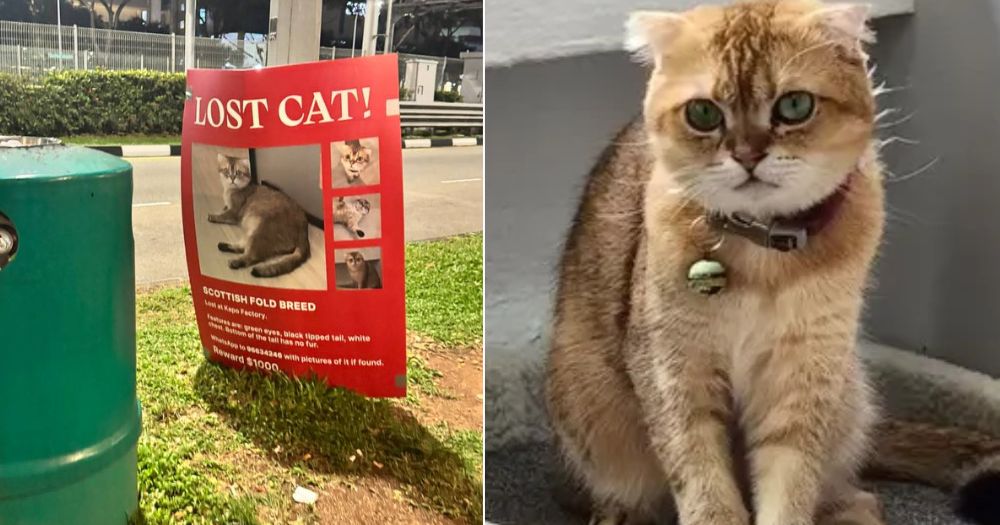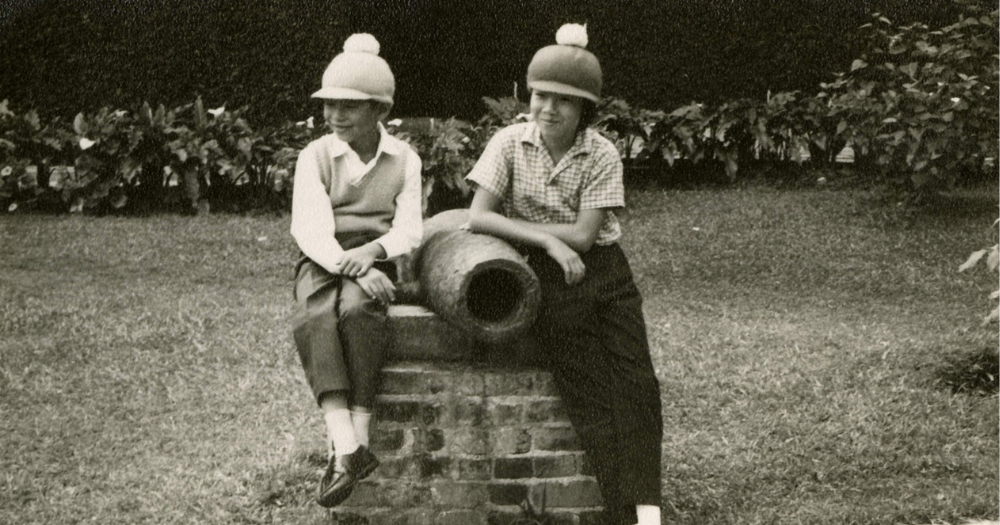S'pore Zoo introduces new 'protected contact' elephant tours, years after stopping rides & shows
What does it look like when elephants are allowed to be elephants?
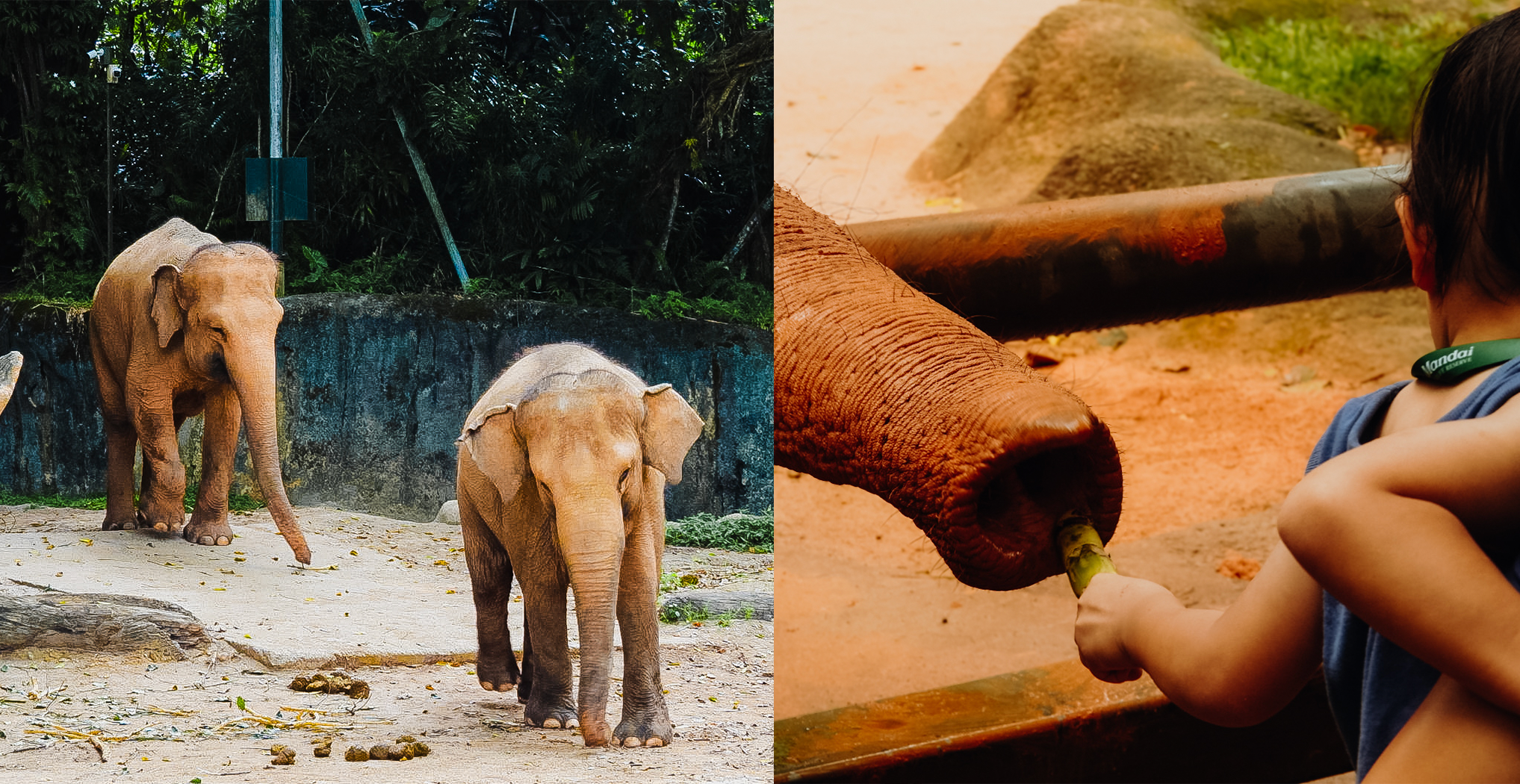
35-year-old Gambir is covered in reddish-brown clay, tail flicking delightedly in the rain, as she ambles over to the gate.
"Actually she was clean just now," Tzu Ying, one of the elephant keepers at the Singapore Zoo, hastens to explain. "We do wash them from time to time... but they really love the rain."
Just moments before, I'd passed by their enclosure. I'd looked up from under my umbrella just in time to see an elephant dump a handful (trunkful?) of clay on its own head.
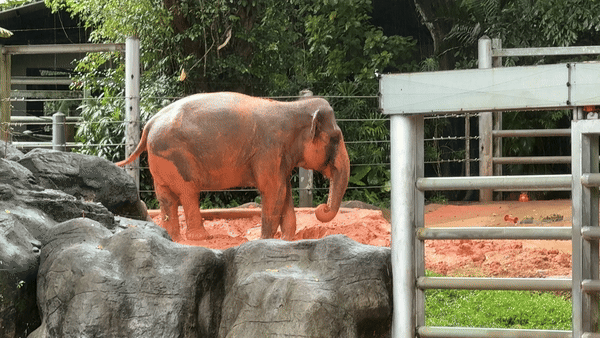 Gif by Ilyda Chua
Gif by Ilyda Chua
Apparently, that had been Gambir.
Strange elephants
There are five elephants in the Singapore Zoo. Gambir's the strangest of the lot, Tzu Ying explains; something that likely has to do with her history.
At just two years old, she was orphaned as a cub. She was later adopted into the herd, but was young enough that she quickly shook off any wariness she might've held for her human keepers.
30-odd years on, she's still unusually affectionate with humans. Unlike her peers, she makes squeaking noises when communicating with her keepers — the elephant equivalent of baby-talk.
"She's a bit of a people-pleaser," Tzu Ying admits.
It's all very cute. But it's also evidence of how the domestication of elephants can lead to some unusual, even unnatural behaviours.
And after all, they are still wild animals.
Protected contact
If you'd visited the zoo some years ago, you might have noticed that some activities, like elephant rides, walks, and shows, have disappeared.
The rides were phased out in 2015 and the show, where they were made to perform tricks like carry and balance on logs, in 2018.
Keepers were also trained "in the traditional method" where they would "command elephants to do certain things".
"The elephants will be allowed to be elephants," the deputy chief executive of Mandai told The Straits Times upon the cessation of the old show.
"In the past, zoos were very focused on generating revenue through entertainment. We've since stopped these activities, because we've shifted our focus to conservation and education," explains fellow keeper Jonathan Pang.
"So we want to connect guests in different ways, in more natural ways. Because it's not natural, you know, that a person is sitting on an elephant's back."
To that end, over the past few years, the zoo has moved to full protected contact.
This means that there is always a barrier between the elephant and any human it might be interacting with; whether it's a keeper, a vet, or a visitor.
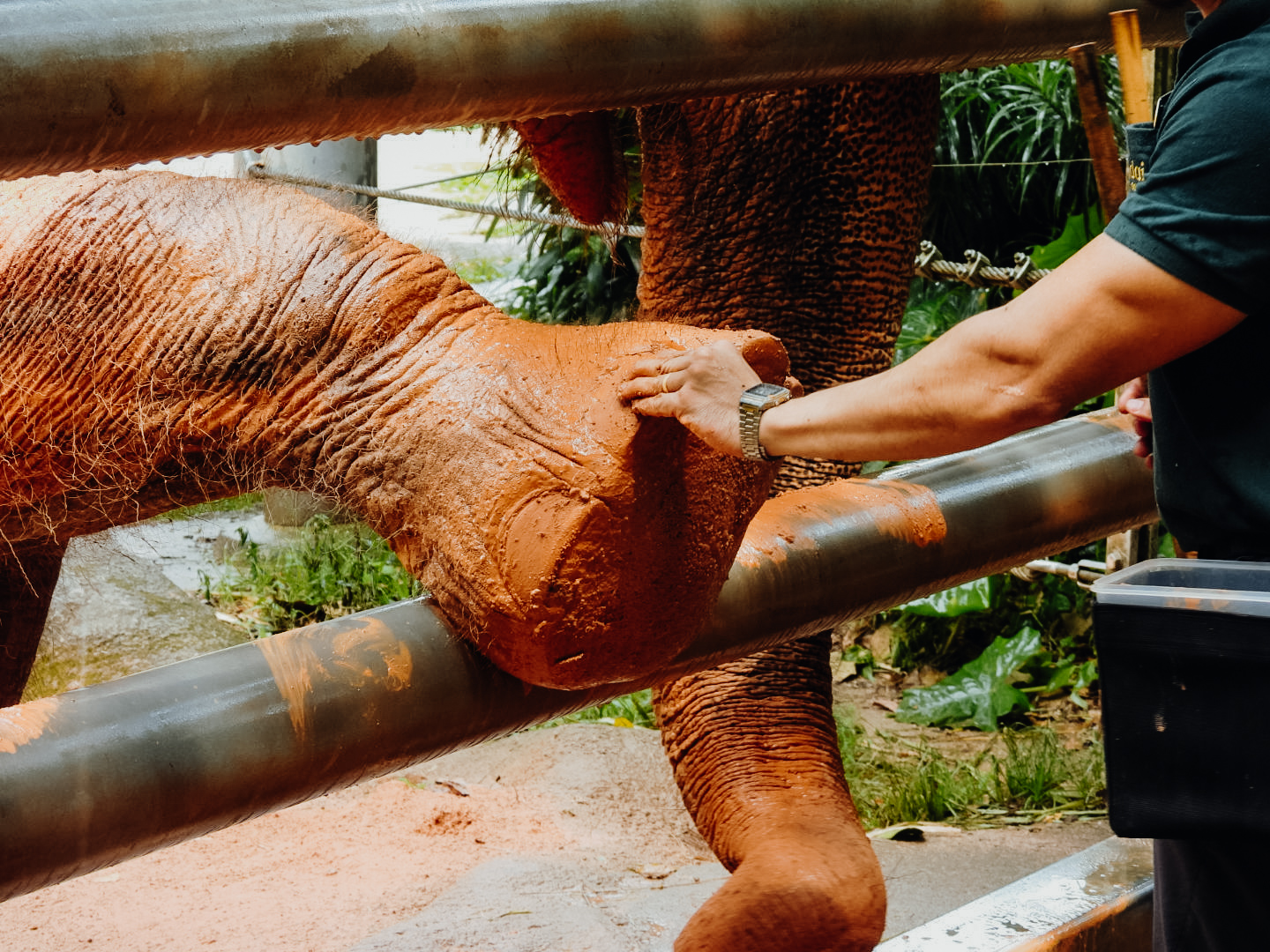 Checking a clay-covered foot through a fence. Photo by Ilyda Chua
Checking a clay-covered foot through a fence. Photo by Ilyda Chua
This has the dual effects of allowing the elephants more autonomy and freedom, as well as safeguarding the humans from potential harm.
Pang explains that prior to protected contact, carrying out their duties was "much riskier". Back in 2001, a male elephant, Chawang, gored his keeper of 18 years, injuring him severely.
"With elephants, even though they don't mean to harm you, just because of their size and strength, a wrong turn or a wrong step could injure someone," he says.
"So for staff safety and everything, we definitely would want to move towards protected contact."
Education and engagement
That being said, it's perfectly natural to want to see animals up close.
There are keeper talks — 30-minute long sessions with short training demonstrations — and the zoo's latest behind-the-scenes tour, Elephant Encounters.
For the entirely pragmatic purpose of getting enough information for the article, I decide to make the trip down.
At the start of the tour, I meet up with our guide, Nicholas. A regular fountain of knowledge, he tells us everything from the differences between Asian and African elephants, to the details of the Singapore Zoo's herd hierarchy (surprisingly complex and political, if you'd believe it).
It begins to rain. The tour is delayed, but as Nicholas regales us with more information, we're all distracted by something else: the elephants, entirely in their element.
Like Tzu Ying said earlier, they really, really love rain.
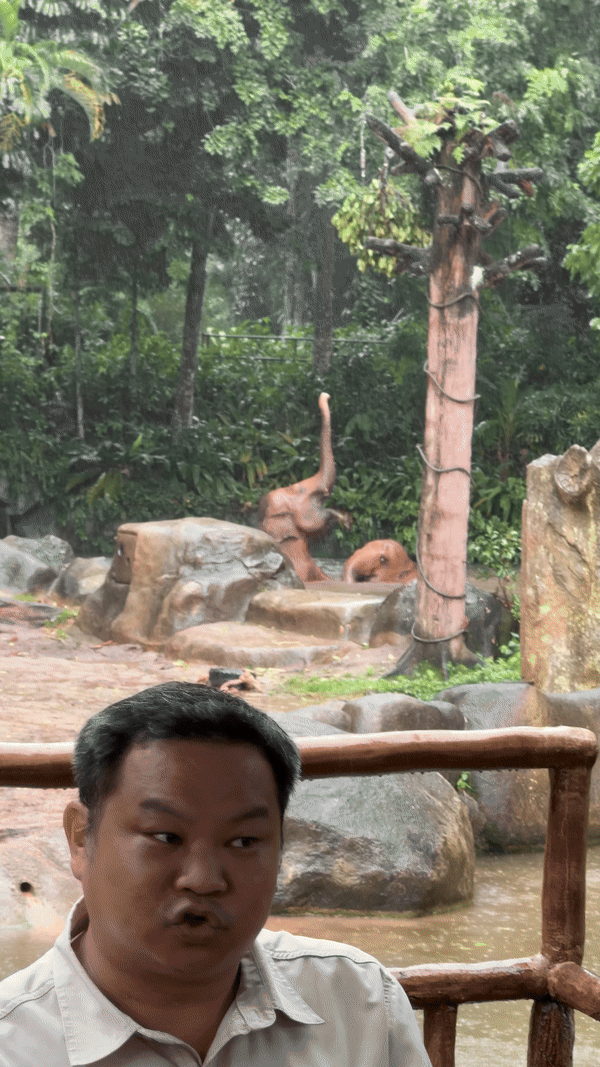 Playing in the water. Gif by Ilyda Chua
Playing in the water. Gif by Ilyda Chua
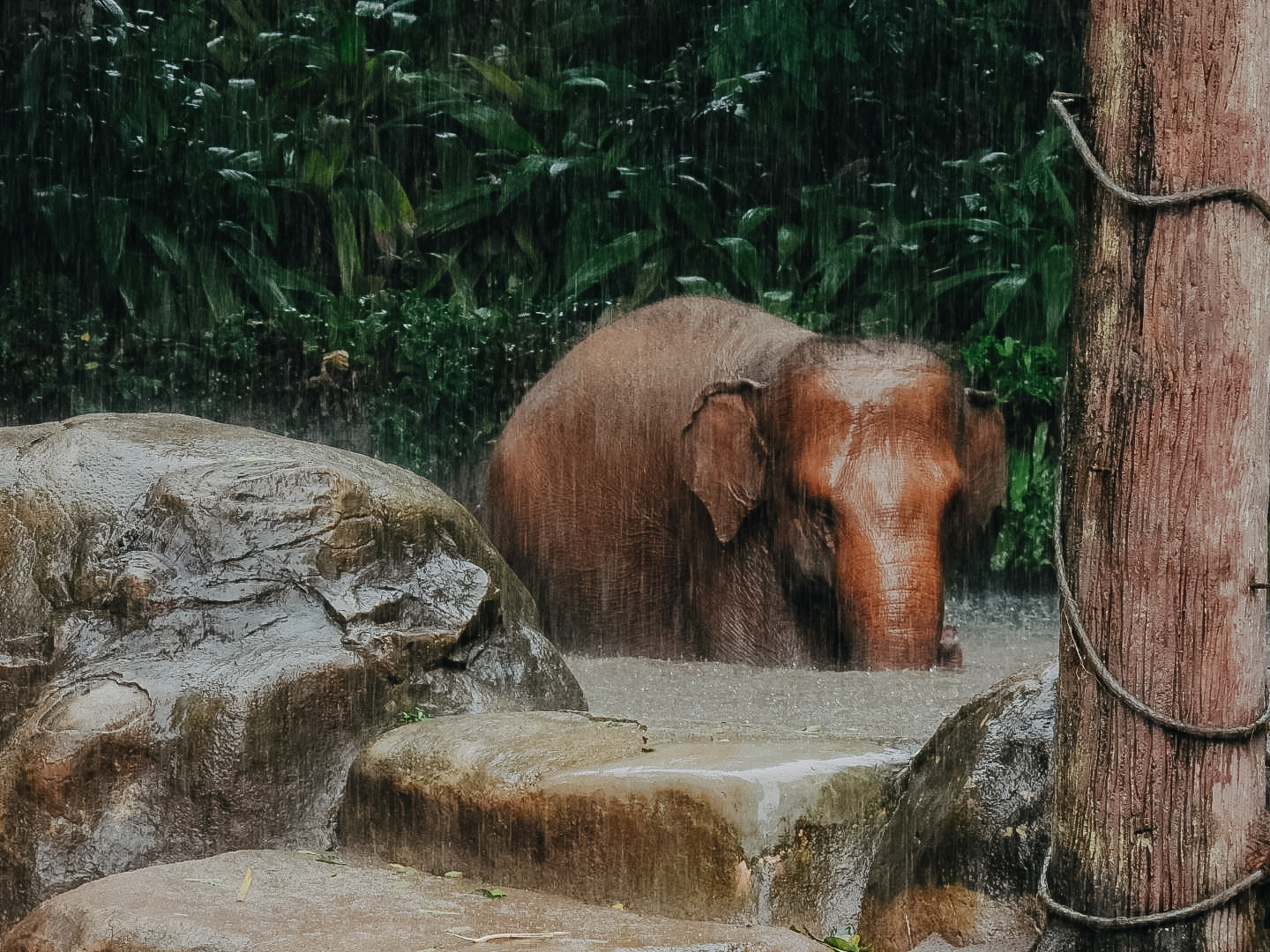 Soaking in an onsen. Photo by Ilyda Chua
Soaking in an onsen. Photo by Ilyda Chua
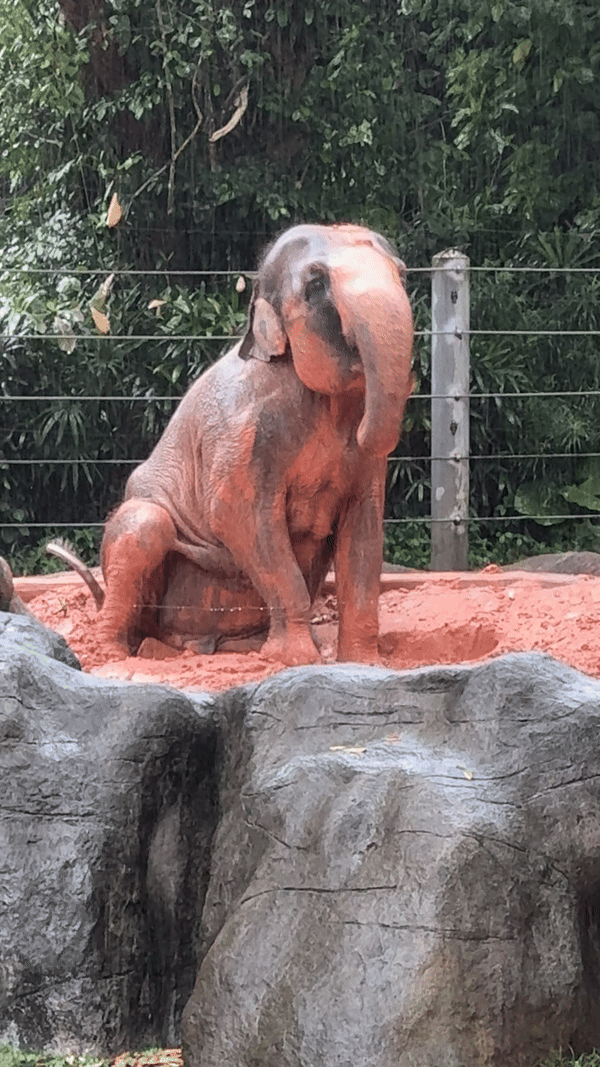 Basking in the mud, because reasons. Gif by Ilyda Chua
Basking in the mud, because reasons. Gif by Ilyda Chua
In our subsequent interview, Pang shares his own first experience of seeing the zoo's elephants in the rain, which he calls "a sight to behold".
"I couldn't get the concept of a huge, three-ton animal, running around at full speed, rolling around in the mud, making trumpeting sounds, screaming its lungs out, just playing with each other," he tells me.
For a solid 15 minutes, he stood there just looking at them play. "It was a whole new experience. Even though they were massive creatures, they had this playful and adorable side to them," he says.
"I didn't mind getting drenched at all."
Getting close and personal
After the rain subsides, we go through a back entrance to a fenced-off area.
Moments later, an elephant — Gambir — comes lumbering up, in search of treats and attention.
We're warned, quite emphatically, not to cross the yellow line. Fortunately, as a born-and-bred Singaporean, that part is easy.
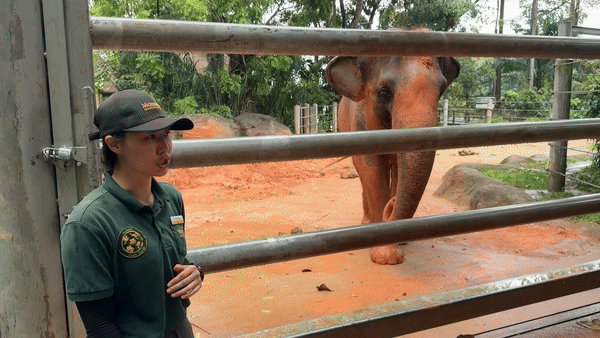 Gif by Ilyda Chua
Gif by Ilyda Chua
Gambir is separated from us by a heavy metal gate — part of the zoo's "protected contact" philosophy.
As the keepers run the playful elephant through a number of poses — like opening her mouth, or leaning against the gate — they do so with a pair of bamboo target sticks, and delicious treats snuck through the bars.
Even when they demonstrate how they clean Gambir, it's done by her helpfully propping a muddy foot up on the bar.
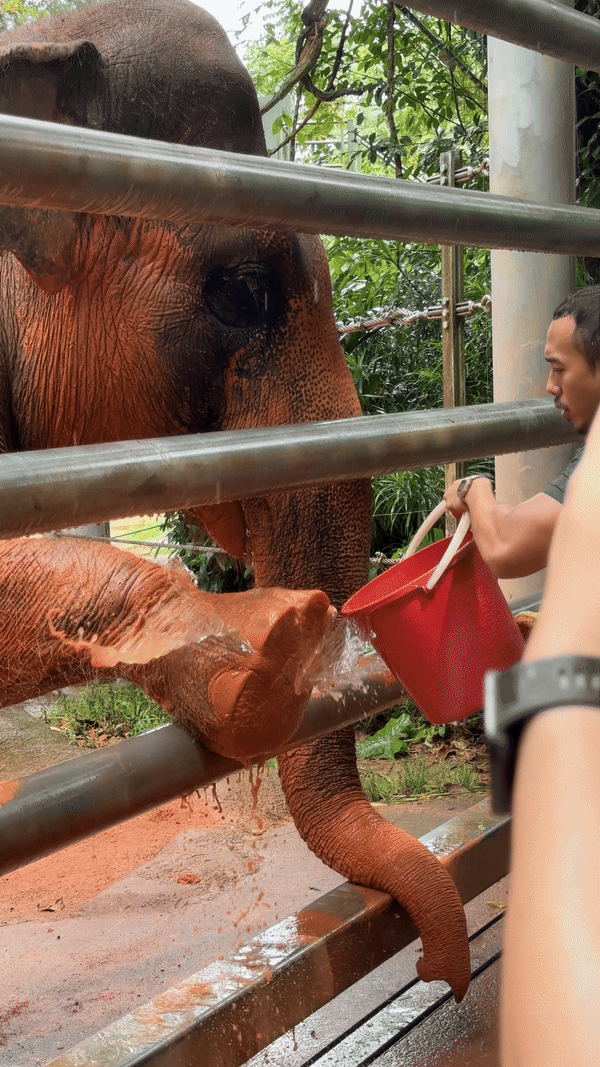 Gif by Ilyda Chua
Gif by Ilyda Chua
Finally, after a few more words of caution, we're allowed to touch the elephants. Tzu Ying demonstrates, pressing a firm hand against Gambir's side.
I do the same. It's both warmer and softer than I'd expected.
These "tricks" — allowing people to touch their sides, or their mouths, or their feet — aren't just for fun either.
They're so the keepers and vets can conduct checks on the different parts of their body. But everything is voluntary; the elephants can always choose to stay (and get treats), or leave if they'd prefer.
"We try our best to keep the elephants comfortable," Tzu Ying explains. I eye Gambir as she happily accepts a thank-you banana from a kid, and think it's not a half-bad deal.
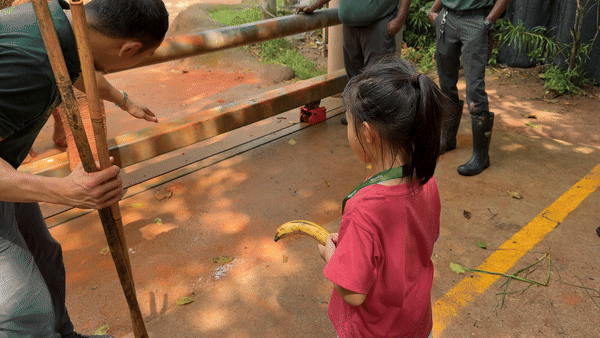 Gif by Ilyda Chua
Gif by Ilyda Chua
Why the need?
And yet — even if they get yummy food for their participation — is using animals to make money ethical? (The tour costs between S$118.40 and S$140, by the way.)
In response, Pang points out a few things. First, the elephants have agency. They're not compelled to participate in the tour, which can in fact proceed even if they refuse to be touched.
Second, the tour allows people to develop an affinity with elephants. "You get to learn so much about these creatures, not only on a science level but also on a personal level," Pang says,
"And then you become an advocate. Like elephants are cool, right, but do you know in the wild they're facing so many threats, like deforestation, and human-animal conflict?...We try to use our animals as conservation ambassadors, to highlight the issues they face."
Thirdly, and finally, it comes down to the money.
Bringing back the programme this year provides the zoo with a new, and likely fairly lucrative, income stream — without the risks of the old programmes.
Just like when you buy a zoo ticket, part of the ticket sales go to funding Mandai's conservation projects. This includes an elephant rescue unit in Sumatra, Pang tells me.
I mull over this. In a perfect world, we wouldn't need elephants to look cute and sell tickets to fund their own survival. There's always going to be a certain element of not-okay-ness to it, I think, no matter how nicely it's packaged.
But in an imperfect world, maybe this is what okay looks like.
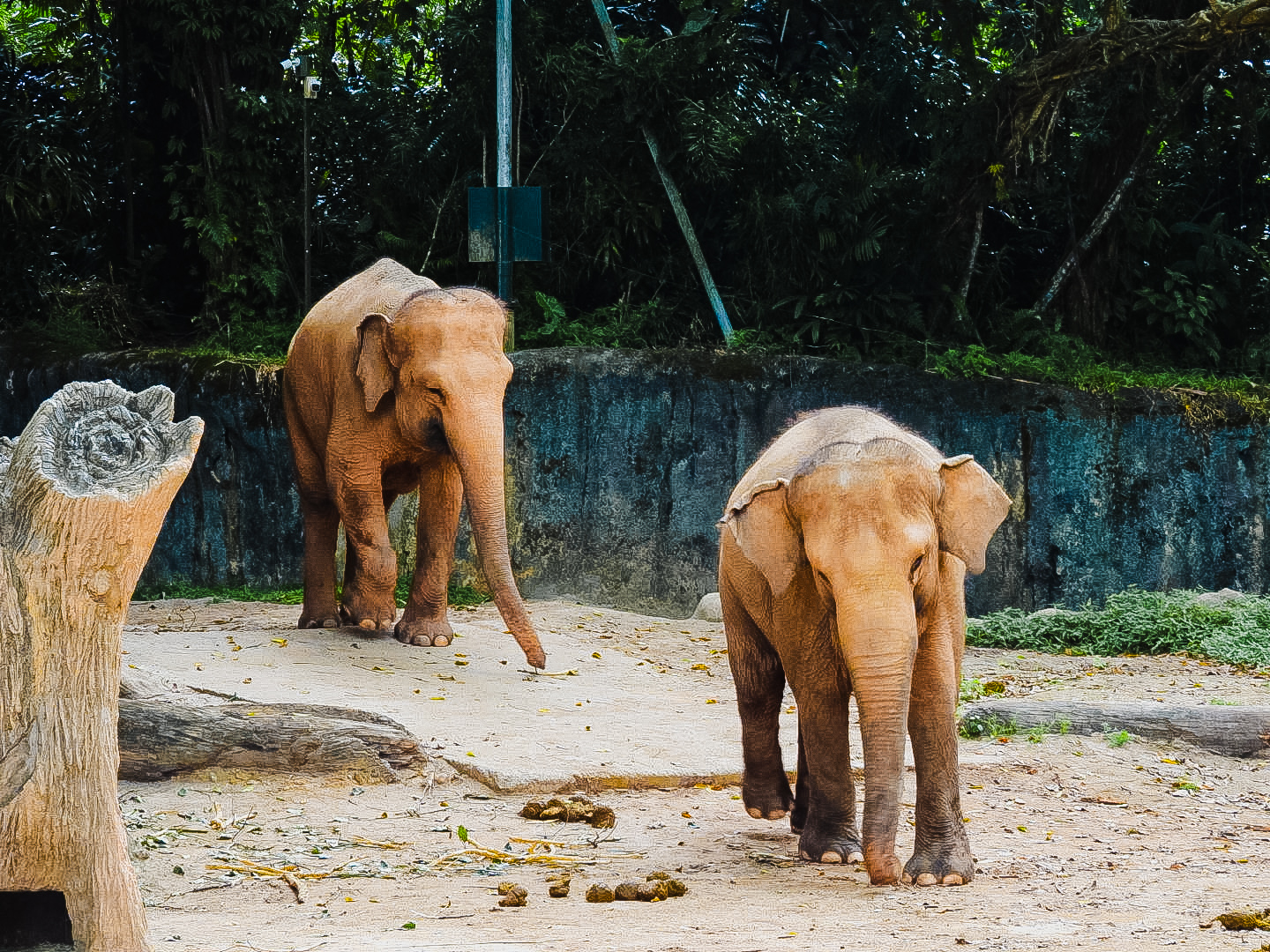 Photo by Ilyda Chua
Photo by Ilyda Chua
Animal ambassadors
It's a careful consideration of both the species, and the individual animal, to assess who is best-suited for such wildlife experiences.
For instance, human-loving Gambir is a good fit; but 54-year-old Komali, the "grouchy old lady" of the herd, only allows humans that she's known for at least two decades to hang out with her.
Saravanan Elangkovan, deputy vice president of animal care at Mandai, adds that the zoo also prioritises species that are "gentle in nature and less prone to aggression or stress".
"We strive to balance featuring charismatic animals such as elephants, giraffes and manatees, with highlighting lesser-known species like the reptiles and invertebrates," he explains.
"This approach helps guests learn about a diverse range of wildlife."
https://mothership.sg/2023/10/owned-insect-singapore-zoo/
Towards the end of our interview, Pang tells me about the different personalities of each elephant. Intan bats her eyes at you when she wants to be affectionate. Komali is best friends with Jati, but struggles to tolerate the younger elephants.
And of course, there's happy-go-lucky Gambir, the "big baby" of the herd, who once got nipped by Komali after a misplaced attempt to play.
I ask him how he feels about the new tour. Is he nervous? Dreading the social interaction? Irritated at the prospect of more work?
"Initially I was nervous," he admits. "Being a keeper, we're not used to interacting so closely with guests, talking to the guests and stuff."
But these days, the keepers have started to look forward to sessions. It gives them "an outlet to vent [their] excitement about elephants," he says, rather sheepishly.
Posing with elephants
Later, I show a friend the fruit of my tour: a photo of me with Gambir, her mouth open and trunk coiled artfully in the air.
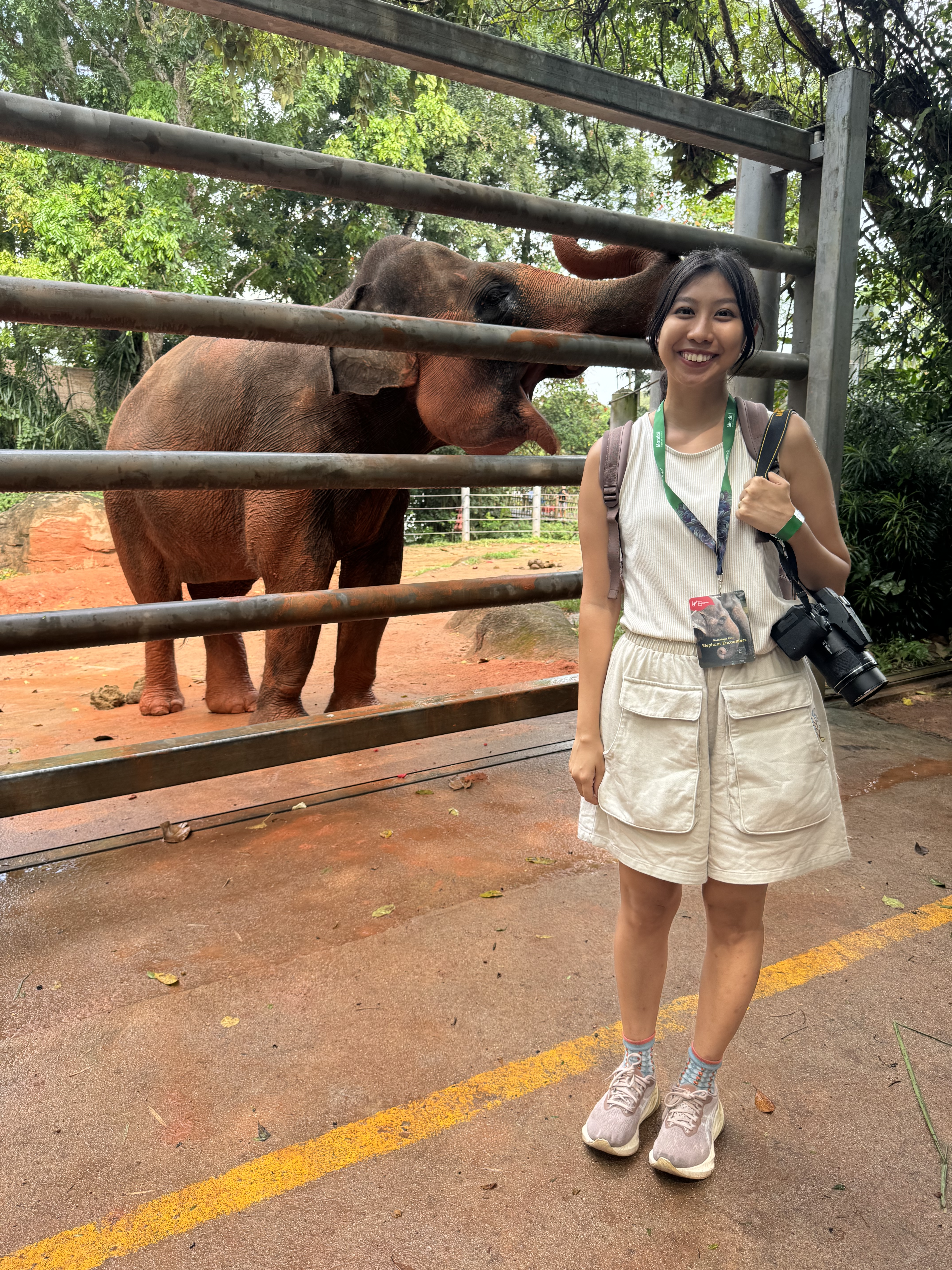 Photo from Ilyda Chua
Photo from Ilyda Chua
"Huh, pay so much then still got fence ah?" the friend remarks.
It's not the most awe-inspiring photo, I guess. Then again, feeding chunks of sugarcane to the world's largest land mammal isn't an experience that can be perfectly captured in a crappy iPhone photo.
I examine the photo again. It's still kind of bittersweet, recalling the fences and the tricks. I don't think it will ever be comfortable, but then again, I don't think zoos are supposed to be.
Like the programme, zoos are educational, entertaining, and important. But there is still a gate, however attractively packaged it may be; and the animals are still in captivity, even if they are well-fed and cared for.
Gambir has not seen the wilds of India since she was two years old. Likely she never will again, and will remain a city-dweller till the day she dies.
But perhaps this is for the best; in the zoo, she will live a full life with all the sugarcane and fruits she can crunch on and all the mud-baths she can enjoy.
And for every human that she captivates, and for every zoo ticket she sells, an elephant out there — someplace in India, or Sumatra, or Sri Lanka — might live to see another day.
It's not a bad fate for an orphaned elephant cub. And there are worse things in life, I suppose, than getting a piece of sugarcane in exchange for showing off your dental work.
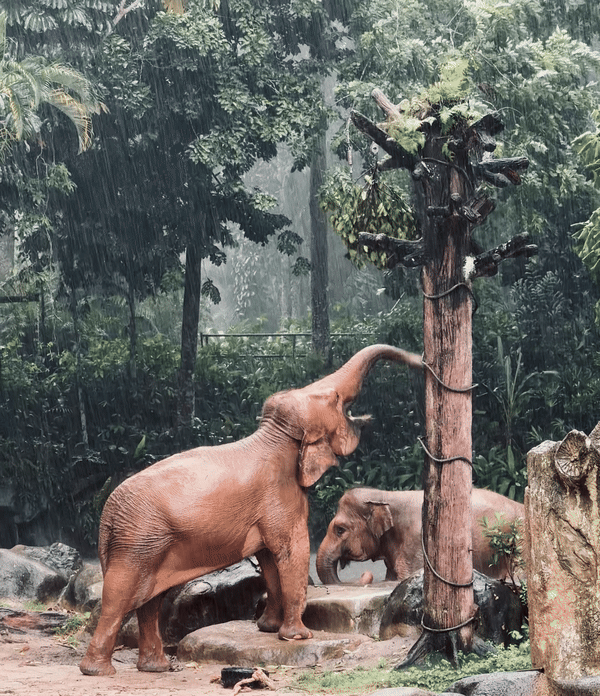 Gif by Ilyda Chua
Gif by Ilyda Chua
Related story
https://mothership.sg/2021/03/jurong-bird-park-keeper-clarence/
Top image by Ilyda Chua
MORE STORIES













